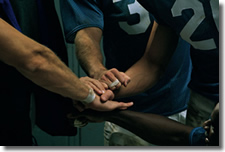Underage Drinking: A Major Public Health Challenge
Download PDF Version What is PDF?
Source: Alcohol Alert, a Journal of the National Institute on Alcohol Abuse and Alcoholism,
No. 59, April, 2003
Public Domain
Table of Contents (TOC)
IntroductionChapter 1: Injury and Social Consequences
Chapter 2: Alcohol’s Effects on the Brain
Chapter 3: The Link Between Early Alcohol Use and Alcohol Dependence
Chapter 4: Prevention and Treatment
Chapter 5: Policy and Community Strategies
Chapter 6: Underage Drinking- A Commentary by NIAAA Director Ting-Kai Li, M.D.
References
By the time they reach the eighth grade, nearly 50 percent of adolescents have had at least one drink, and over 20 percent report having been “drunk”.1 Approximately 20 percent of 8th graders and almost 50 percent of 12th graders have consumed alcohol within the past 30 days.1 Among 12th graders, almost 30 percent report drinking on 3 or more occasions per month.2 Approximately 30 percent of 12th graders engage in heavy episodic drinking, now popularly termed “binge” drinking—that is, having at least five or more drinks on one occasion within the past 2 weeks—and it is estimated that 20 percent do so on more than one occasion.2
 Apart from being illegal, underage drinking poses a high
risk to both the individual and society.3 For example,
the rate of alcohol–related traffic crashes is greater
for drivers ages 16 to 20 than for drivers age 21 and older.4 Adolescents also are vulnerable to alcohol–induced
brain damage, which could contribute to poor performance
at school or work. In addition, youthful drinking is associated
with an increased likelihood of developing alcohol abuse
or dependence later in life. Early intervention is essential
to prevent the development of serious alcohol problems among
youth between the ages of 12 and 20. This Alcohol Alert describes
some of the most harmful consequences of underage drinking
as well as prevention and treatment approaches that can
be applied successfully to meet the unique needs of this
age group.
Apart from being illegal, underage drinking poses a high
risk to both the individual and society.3 For example,
the rate of alcohol–related traffic crashes is greater
for drivers ages 16 to 20 than for drivers age 21 and older.4 Adolescents also are vulnerable to alcohol–induced
brain damage, which could contribute to poor performance
at school or work. In addition, youthful drinking is associated
with an increased likelihood of developing alcohol abuse
or dependence later in life. Early intervention is essential
to prevent the development of serious alcohol problems among
youth between the ages of 12 and 20. This Alcohol Alert describes
some of the most harmful consequences of underage drinking
as well as prevention and treatment approaches that can
be applied successfully to meet the unique needs of this
age group.
Underage alcohol use is more likely to kill young people than all illegal drugs combined.5, 6 Some of the most serious and widespread alcohol–related problems among adolescents are discussed below. For a more detailed discussion of alcohol problems in the college–age population, see Alcohol Alert No. 58.7
Drinking and Driving. Motor vehicle crashes are the leading cause of death among youth ages 15 to 20.8 Adolescents already are at increased risk through their relative lack of driving experience,9 and drivers younger than 21 are more susceptible than older drivers to the alcohol–induced impairment of driving skills.4, 9 The rate of fatal crashes among alcohol–involved drivers between 16 and 20 years old is more than twice the rate for alcohol–involved drivers 21 and older.10
Suicide. Alcohol use interacts with conditions such as depression and stress to contribute to suicide, the third leading cause of death among people between the ages of 14 and 25.11, 12 In one study, 37 percent of eighth grade females who drank heavily reported attempting suicide, compared with 11 percent who did not drink.13
 Sexual Assault. Sexual assault, including
rape, occurs most commonly among women in late adolescence
and early adulthood, usually within the context of a date.14 In one survey, approximately 10 percent of female
high school students reported having been raped.5 Research
suggests that alcohol use by the offender, the victim, or
both, increases the likelihood of sexual assault by
a male acquaintance.15
Sexual Assault. Sexual assault, including
rape, occurs most commonly among women in late adolescence
and early adulthood, usually within the context of a date.14 In one survey, approximately 10 percent of female
high school students reported having been raped.5 Research
suggests that alcohol use by the offender, the victim, or
both, increases the likelihood of sexual assault by
a male acquaintance.15
High–Risk Sex. Research has associated adolescent alcohol use with high–risk sex (for example, having multiple sexual partners and failing to use condoms). The consequences of high–risk sex also are common in this age group, particularly unwanted pregnancy and sexually transmitted diseases, including HIV/AIDS.5 According to a recent study, the link between high–risk sex and drinking is affected by the quantity of alcohol consumed. The probability of sexual intercourse is increased by drinking amounts of alcohol sufficient to impair judgment, but decreased by drinking heavier amounts that result in feelings of nausea, passing out, or mental confusion.16
Adolescence is the transition between childhood and adulthood. During this time, significant changes occur in the body, including rapid hormonal alterations and the formation of new networks in the brain.17 Adolescence is also a time of trying new experiences and activities that emphasize socializing with peers, and conforming to peer–group standards.18, 19 These new activities may place young people at particular risk for initiating and continuing alcohol consumption. Exposing the brain to alcohol during this period may interrupt key processes of brain development, possibly leading to mild cognitive impairment as well as to further escalation of drinking. (For a review, see Reference 17.)17
 Subtle alcohol–induced adolescent learning impairments
could affect academic and occupational achievement.17
In one study, Brown and colleagues20 evaluated short–term
memory skills in alcohol–dependent and nondependent
adolescents ages 15 to 16. The alcohol–dependent youth
had greater difficulty remembering words and simple geometric
designs after a 10–minute interval. In this and similar
studies,21, 22 memory problems were most common among
adolescents in treatment who had experienced alcohol withdrawal
symptoms.20 The emergence of withdrawal symptoms generally
indicates an established pattern of heavy drinking. Their
appearance at a young age underscores the need for early
intervention to prevent and treat underage drinking.
Subtle alcohol–induced adolescent learning impairments
could affect academic and occupational achievement.17
In one study, Brown and colleagues20 evaluated short–term
memory skills in alcohol–dependent and nondependent
adolescents ages 15 to 16. The alcohol–dependent youth
had greater difficulty remembering words and simple geometric
designs after a 10–minute interval. In this and similar
studies,21, 22 memory problems were most common among
adolescents in treatment who had experienced alcohol withdrawal
symptoms.20 The emergence of withdrawal symptoms generally
indicates an established pattern of heavy drinking. Their
appearance at a young age underscores the need for early
intervention to prevent and treat underage drinking.
Although the prevalence of high–risk drinking declines after early adulthood,23 alcohol–induced brain damage may persist. Memory impairment has been found in adult rats exposed to alcohol during adolescence.17 In addition, sophisticated imaging techniques revealed structural differences in the brains of 17–year–old adolescents who displayed alcohol–induced intellectual and behavioral impairment. Specifically, the hippocampus—a part of the brain important for learning and memory—was smaller in alcohol–dependent study participants than it was in nondependent participants.24 Adolescents who began drinking at an earlier age had proportionately smaller hippocampal volumes compared with those who began later,24 suggesting that the differences in size were alcohol induced.
Early alcohol use may have long–lasting consequences. People who begin drinking before age 15 are four times more likely to develop alcohol dependence at some time in their lives compared with those who have their first drink at age 20 or older.25 It is not clear whether starting to drink at an early age actually causes alcoholism or whether it simply indicates an existing vulnerability to alcohol use disorders.26 For example, both early drinking and alcoholism have been linked to personality characteristics such as strong tendencies to act impulsively and to seek out new experiences and sensations.27 Some evidence indicates that genetic factors may contribute to the relationship between early drinking and subsequent alcoholism.28, 29 Environmental factors may also be involved, especially in alcoholic families, where children may start drinking earlier because of easier access to alcohol in the home, family acceptance of drinking, and lack of parental monitoring.27, 26
 The immediate and long–term risks associated with
adolescent alcohol use underscore the need for effective
prevention and treatment programs. Research on the personal,
social, and environmental factors that contribute to the
initiation and escalation of drinking is essential for the
development of such programs. It should be noted that preventing and
identifying alcohol use disorders in youth require different
screening, assessment, and treatment approaches than those
used for adults.30, 31 For example, although relapse rates
following alcoholism treatment are similar for both adults
and adolescents, social factors such as peer pressure play
a much larger role in relapse among adolescents.31
The immediate and long–term risks associated with
adolescent alcohol use underscore the need for effective
prevention and treatment programs. Research on the personal,
social, and environmental factors that contribute to the
initiation and escalation of drinking is essential for the
development of such programs. It should be noted that preventing and
identifying alcohol use disorders in youth require different
screening, assessment, and treatment approaches than those
used for adults.30, 31 For example, although relapse rates
following alcoholism treatment are similar for both adults
and adolescents, social factors such as peer pressure play
a much larger role in relapse among adolescents.31
Personal factors such as childhood behavior problems32 or a family history of alcohol use disorders33 can help to identify high–risk youth and may suggest direction for interventions. Evidence suggests that the most reliable predictor of a youth’s drinking behavior is the drinking behavior of his or her friends.32, 34 Many research–based interventions target the child’s relevant behavioral skills, such as his or her ability to react appropriately to peer pressure to drink, as well as his or her knowledge, attitudes, and intentions regarding alcohol use.35 Positive beliefs about alcohol’s effects and the social acceptability of drinking encourage the adolescent to begin and continue drinking. However, youth often overestimate how much their peers drink and how positive their peers’ attitudes are toward drinking. Consequently, most prevention programs include social norms education, which uses survey data to counter students’ misperceptions of their peers’ drinking practices and attitudes about alcohol.36, 35
Family factors, such as parent–child relationships,
discipline methods, communication, monitoring and supervision,
and parental involvement, also exert a significant influence
on youthful alcohol use.37, 38 Accordingly, family–based
prevention programs for youth have been developed—for
example, Iowa’s Strengthening Families Program, which
significantly delayed initiation of alcohol use by improving
parenting skills and family bonding.37 The beneficial
effects of this program on student alcohol involvement were
still evident 4 years after the intervention.39
Accordingly, family–based
prevention programs for youth have been developed—for
example, Iowa’s Strengthening Families Program, which
significantly delayed initiation of alcohol use by improving
parenting skills and family bonding.37 The beneficial
effects of this program on student alcohol involvement were
still evident 4 years after the intervention.39
Some school–based programs are aimed at adolescents who have already begun drinking. Preliminary research also has found promise in high school–based motivational programs that encourage self–change in problem drinkers.30
Another important factor in underage drinking is availability, that is, the degree of effort required to obtain alcohol, as determined by geographic, economic, and social factors.40, 35 Consequently, interventions aimed at the individual must be supplemented by policy changes to help reduce youth access to alcohol and decrease the harmful consequences of established drinking.35 For example, raising the minimum legal drinking age in all States to 21 saved an estimated 20,000 lives between 1975 and 2000.8 In addition, all States now have zero–tolerance laws, which set the legal blood alcohol limit for drivers younger than age 21 at 0.00 or 0.02 percent.41 This policy has been associated with a 20–percent decline in the proportion of single–vehicle, nighttime fatal crashes among drivers younger than age 21.42, 43
 The drinking and driving laws described above were implemented in the
absence of an accompanying increase in existing law enforcement levels.
The effectiveness of such measures is enhanced by integrating them into
community–based strategies that involve the cooperation of local
government agencies, the law enforcement community, business leaders, and
grassroots organizations.35 Communities Mobilizing for Change on Alcohol
(CMCA) is an example of a community–wide program that focused on
policy changes to reduce youth access to commercial and social sources
of alcohol.44, 35 Communities that adopted the program experienced significantly
fewer arrests for drinking and driving among youth ages 18 to 20 than
did neighboring communities.45
The drinking and driving laws described above were implemented in the
absence of an accompanying increase in existing law enforcement levels.
The effectiveness of such measures is enhanced by integrating them into
community–based strategies that involve the cooperation of local
government agencies, the law enforcement community, business leaders, and
grassroots organizations.35 Communities Mobilizing for Change on Alcohol
(CMCA) is an example of a community–wide program that focused on
policy changes to reduce youth access to commercial and social sources
of alcohol.44, 35 Communities that adopted the program experienced significantly
fewer arrests for drinking and driving among youth ages 18 to 20 than
did neighboring communities.45
Comprehensive Interventions. Project Northland is an example of a successful comprehensive intervention that incorporated family, school, and community components to prevent or reduce alcohol use among adolescents. To determine the program’s effectiveness, researchers began testing the students in grade six; and, after 3 years, the prevalence of alcohol use by eighth graders was lower in intervention communities than in comparison sites, and especially among students who had not yet started drinking when the program began.46 During the next 2 years, interventions were only minimal, and the differences in the measures of alcohol use between the two groups of students disappeared. However, resumption of Project Northland activities in grades 11 and 12 had a significant positive effect on the students’ tendency to avoid alcohol use and binge drinking. Taken together, these results show the effectiveness of continued, age–appropriate prevention activities for delaying or reducing underage drinking.47
The immediate and long–term risks associated with adolescent alcohol use underscore the need for effective prevention and treatment programs. Research toward those ends is a top priority at NIAAA. Studies have revealed genetic, biologic, developmental, and environmental influences on underage drinking.
 Scientists have found that variability is a crucial aspect of alcohol
problems across all age groups and thus is a key consideration in alcohol
research. For example, there is a three– to fourfold between–individual
variation in the rate of absorption, distribution, and elimination of
alcohol (pharmacokinetics) and a two– to threefold between–individual
variation in the sensitivity of the brain to the effects of a given concentration
of alcohol (pharmacodynamics). Understanding the underlying causes of
this variability, both genetic and nongenetic, should provide insights
into underage drinking and binge–drinking patterns.
Scientists have found that variability is a crucial aspect of alcohol
problems across all age groups and thus is a key consideration in alcohol
research. For example, there is a three– to fourfold between–individual
variation in the rate of absorption, distribution, and elimination of
alcohol (pharmacokinetics) and a two– to threefold between–individual
variation in the sensitivity of the brain to the effects of a given concentration
of alcohol (pharmacodynamics). Understanding the underlying causes of
this variability, both genetic and nongenetic, should provide insights
into underage drinking and binge–drinking patterns.
Through prevention and intervention strategies directed at the individual, family, school, and community, we aim to provide knowledge and change belief systems and social norms to reinforce the message that underage alcohol use is unacceptable. We also aim to enhance young peoples’ self–esteem, self–motivation, and identity formation to enable them to take responsibility for their own health by making informed, deliberate, and healthy choices regarding alcohol use.
Various intervention tools have brought about positive behavioral change with regard to underage drinking. Further studies will follow cohorts of young people from childhood through the college years, at different locations and in different settings, to determine whether these interventions are enduring and broadly applicable. Finding lasting solutions to such an entrenched problem will not be easy, but we are confident that diligent research efforts will meet this urgent challenge.
(1) Johnston, L.D.; O’Malley, P.M.; and Bachman, J.G. Monitoring the Future: National Results on Adolescent Drug Use. Overview of Key Findings, 2002. NIH Pub. No. 03–5374. Bethesda, MD: National Institute on Drug Abuse (NIDA), 2003.
(2) Johnston, L.D.; O’Malley, P.M.; and Bachman, J.G. Monitoring the Future: National Survey Results on Drug Use, 1975–2001. Vol. II: College Students and Adults Ages 19–40. NIH Pub. No. 02–5107. Bethesda, MD: NIDA, 2002.
(3) O’Malley, P.M.; Johnston, L.D.; and Bachman, J.G. Alcohol use among adolescents. Alcohol Health & Research World 22(2):85–93, 1998.
(4) Zador, P.L.; Krawchuk, S.A.; and Voas, R.B. Driver–related relative risk of driver fatalities and driver involvement in fatal crashes in relation to driver age and gender: An update using 1996 data. Journal of Studies on Alcohol 61(3): 387–395, 2000.
(5) Grunbaum, J.A.; Kann, L.; Kinchen, S.A.; et al. Youth risk behavior surveillance: United States, 2001. MMWR: Morbidity and Mortality Weekly Report 51(SS0 4): 1–62, 2002.
(6) Young, S.E.; Corley, R.P.; Stallings, M.C.; et al. Substance use, abuse and dependence in adolescence: Prevalence, symptom profiles and correlates. Drug and Alcohol Dependence 68(3):309–322, 2002.
(7) National Institute on Alcohol Abuse and Alcoholism (NIAAA). Changing the culture of campus drinking. Alcohol Alert No. 58. Rockville, MD: NIAAA, 2002.
(8) National Highway Traffic Safety Administration (NHTSA). Traffic Safety Facts 2000: Young Drivers. DOT HS–809–336. Washington, DC: NHTSA, 2001.
(9) National Institute on Alcohol Abuse and Alcoholism (NIAAA). Alcohol and transportation safety. Alcohol Alert No. 52. Rockville, MD: NIAAA, 2001.
(10) Yi, H.Y.; Williams, G.D.; and Dufour, M.C. Trends in Alcohol–Related Fatal Crashes, United States, 1979–99. Surveillance Report No. 56. Bethesda, MD: NIAAA, 2001.
(11) Anderson, R.N. Deaths: Leading Causes for 1999. National Vital Statistics Reports 49(11). DHHS Pub. No. PHS 20012–1120. Hyattsville, MD: Centers for Disease Control and Prevention, 2001.
(12) Garlow, S.J. Age, gender, and ethnicity differences in patterns of cocaine and ethanol use preceding suicide. American Journal of Psychiatry 159(4):615–619, 2002.
(13) Windle, M.; Miller–Tutzauer, C.; and Domenico, D. Alcohol use, suicidal behavior, and risky activities among adolescents. Journal of Research on Adolescence 2(4):317–330, 1992.
(14) Abbey, A.; Zawacki, T.; Buck, P.O.; et al. Alcohol and sexual assault. Alcohol Research & Health 25(1):43–51, 2001.
(15) Abbey, A. Alcohol–related sexual assault: A common problem among college students. Journal of Studies on Alcohol (Suppl. 14):118–128, 2002.
(16) Sen, G. Does alcohol increase the risk of sexual intercourse among adolescents? Evidence from the NLSY97. Journal of Health Economics 21: 1085–1093, 2002.
(17) Spear, L. Adolescent brain and the college drinker: Biological basis of propensity to use and misuse alcohol. Journal of Studies on Alcohol (Suppl. 14):71–81, 2002.
(18) Cloninger, C.R.; Sigvardsson S.; and Bohman, M. Childhood personality predicts alcohol abuse in young adults. Alcoholism: Clinical and Experimental Research 12(4): 494–505, 1988.
(19) Baumrind, D. A developmental perspective on adolescent risk–taking behavior in contemporary America. In: Damon, W., ed. Adolescent Social Behavior and Health. San Francisco: Jossey–Bass, 1987. pp. 93–126.
(20) Brown, S.A.; Tapert, S.F.; Granholm, E.; and Delis, D.C. Neurocognitive functioning of adolescents: Effects of protracted alcohol use. Alcoholism: Clinical and Experimental Research 24(2): 164–171, 2000.
(21) Tapert, S.F., and Brown, S.A. Neuropsychological correlates of adolescent substance abuse: Four–year outcomes. Journal of the International Neuropsychological Society 5(6):481–493, 1999.
(22) Tapert, S.F.; Brown, G.G.; Kindermann, S.S.; et al. fMRI measurement of brain dysfunction in alcohol–dependent young women. Alcoholism: Clinical and Experimental Research 25(2):236–245, 2001.
(23) Johnston, L.D.; O’Malley, P.M.; and Bachman, J.G. (December 16, 2002). Ecstasy use among American teens drops for the first time in recent years and overall drug and alcohol use also decline in the year after 9/11. University of Michigan News and Information Services: Ann Arbor, MI [Online]. Available: http:monitoringthefuture.org/data/02data.html#2002data–drugs.
(24) De Bellis, M.D.; Clark, D.B.; Beers, S.R.; et al. Hippocampal volume in adolescent–onset alcohol use disorders. American Journal of Psychiatry 157(5):737–744, 2000.
(25) Grant, B.F., and Dawson, D.A. Age of onset of alcohol use and its association with DSM–IV alcohol abuse and dependence: Results from the National Longitudinal Alcohol Epidemiologic Survey. Journal of Substance Abuse 9:103–110, 1997.
(26) Dawson, D.A. The link between family history and early onset alcoholism: Earlier initiation of drinking or more rapid development of dependence? Journal of Studies on Alcoholism 61(5): 637–646, 2000.
(27) Rose, R.J. A developmental behavior–genetic perspective on alcoholism risk. Alcohol Health & Research World 22(2):131–143, 1998.
(28) Virkkunen, M., and Linnoila, M. Serotonin in early–onset alcoholism. In: Galanter, M., ed. Recent Developments in Alcoholism. Vol 13: Alcohol and Violence. New York: Plenum Press, 1997. pp. 173–189.
(29) Kono, Y.; Yoneda, H.; Sakai, T.; et al. Association between early–onset alcoholism and the dopamine D2 receptor gene. American Journal of Medical Genetics (Neuropsychiatric Genetics) 74(2):179–182, 1997.
(30) Brown, S.A. Facilitating change for adolescent alcohol problems: A multiple options approach. In: Wagner, E.F., and Waldron, H.B., eds. Innovations in Adolescent Substance Abuse Interventions. New York: Pergamon, 2001. pp. 169–187.
(31) Brown, S.A., and D’Amico, E.J. Outcomes of alcohol treatment for adolescents. In: Galanter, M., ed. Research Developments in Alcoholism, Vol. 15: Services Research in the Era of Managed Care. New York: Kluwer Academic/Plenum, 2001. pp. 307–327.
(32) Deas, D., and Thomas, S.E. Comorbid psychiatric factors contributing to adolescent alcohol and other drug use. Alcohol Research & Health 26(2):116–121, 2002.
(33) Grant, B.F. The impact of a family history of alcoholism on the relationship between age at onset of alcohol use and DSM–IV alcohol dependence. Alcohol Health & Research World 22(2):144–148, 1998.
(34) Weitzman, E.R.; Nelson, T.F.; and Wechsler, H. Taking up binge drinking in college: The influences of person, social group, and environment. Journal of Adolescent Health 32(1):26–35, 2003.
(35) Komro, K.A., and Toomey, T.L. Strategies to prevent underage drinking. Alcohol Research & Health 26(1):5–14, 2002.
(36) Baer, J.S. Student factors: Understanding inpidual variation in college drinking. Journal of Studies on Alcohol (Suppl. 14):40–53, 2002.
(37) Spoth, R.; Redmond, C.; and Lepper, H. Alcohol initiation outcomes of universal family–focused preventive interventions: One– and two–year follow–ups of a controlled study. Journal of Studies on Alcohol (Suppl. 13):103–111, 1999.
(38) Resnick, M.D.; Bearman, P.S.; Blum, R.W.; et al. Protecting adolescents from harm: Findings from the National Longitudinal Study on Adolescent Health. JAMA: Journal of the American Medical Association 278(10):823–832, 1997.
(39) Spoth, R.L.; Redmond, C.; and Shin, C. Randomized trial of brief family interventions for general populations: Adolescent substance use outcomes 4 years following baseline. Journal of Consulting and Clinical Psychology 69(4):627–642, 2001.
(40) D’Amico, E.J.; Barnett, N.P.; Monti, P.M.; et al. Does alcohol use mediate the association between alcohol evaluations and alcohol–related problems in adolescents? Psychology of Addictive Behaviors 16(2):157–160, 2002.
(41) Lacey, J.H.; Jones, R.K.; and Wiliszowski, C.H. Zero Tolerance for Youth: Four States’ Experience. DOT HS–809–053. Washington, DC: NHTSA, 2000.
(42) Hingson, R.; Heeren, T.; and Winter, M. Lower legal blood alcohol limits for young drivers. Public Health Reports 109(6): 738–744, 1994.
(43) Hingson, R.; McGovern, T.; Howland, J.; et al. Reducing alcohol–impaired driving in Massachusetts: The Saving Lives Program. American Journal of Public Health 86(6):791–797, 1996.
(44) Wagenaar, A.C.; Murphy, D.M.; Gehan, J.P.; et al. Communities Mobilizing for Change on Alcohol: Outcomes from a randomized community trial. Journal of Studies on Alcohol 61:85–94, 2000.
(45) Wagenaar, A.C.; Murray, D.; Toomey, T. Communities Mobilizing for Change on Alcohol (CMCA): Effects of a randomized trial on arrests and traffic crashes. Addiction 95:209–217, 2000.
(46) Perry, C.L.; Williams, C.L.; Veblen–Mortenson, S.; et al. Project Northland: Outcomes of a communitywide alcohol use prevention program during adolescence. American Journal of Public Health 86(7):956–965, 1996.
(47) Perry, C.L.; Williams, C.L.; Komro, K.A.; et al. Project Northland: Long–term outcomes of community action to reduce alcohol use. Health Education Research 17(1):117–132, 2002.


